Nic Dowse of Honey Fingers builds a swarm trap
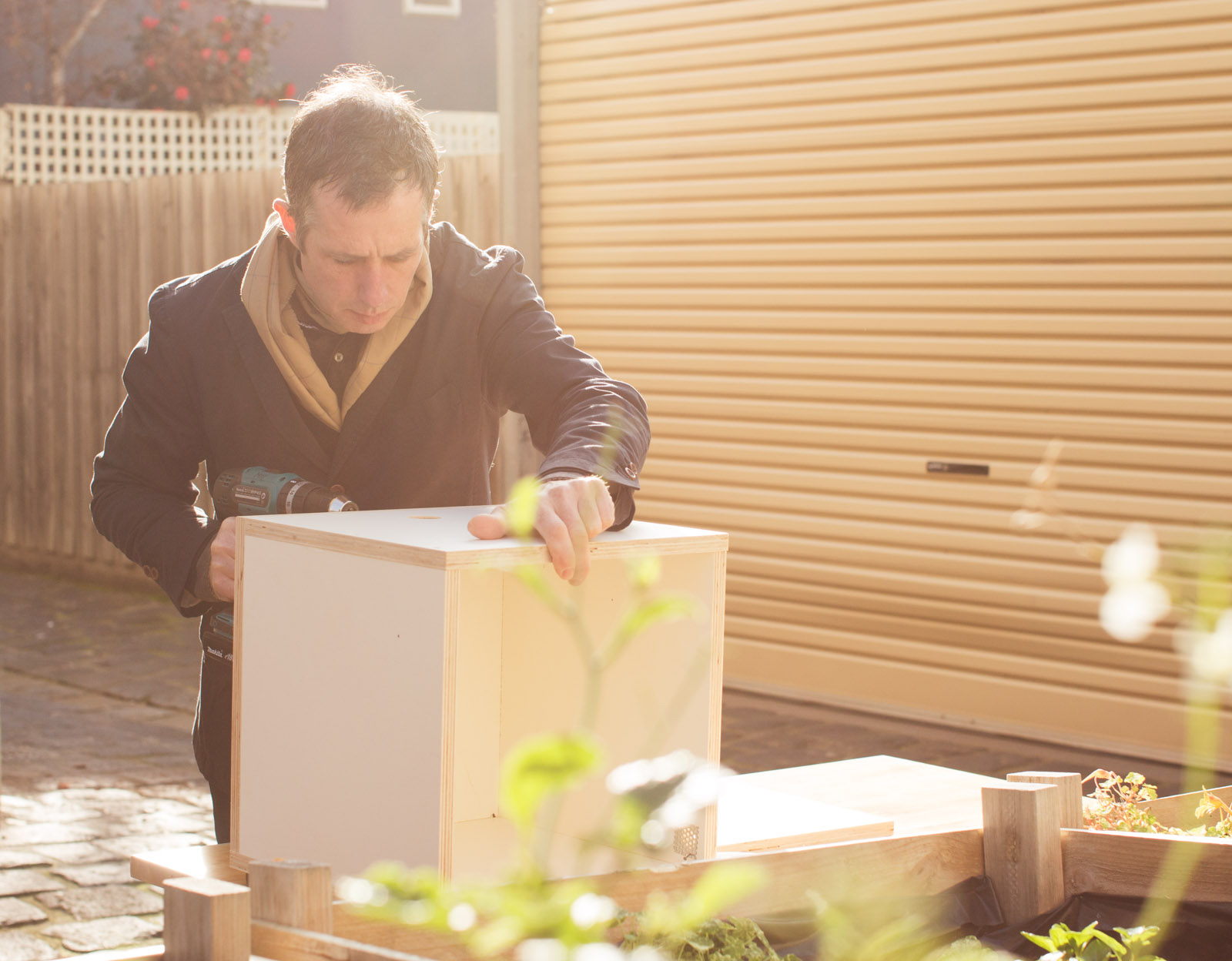
Australia is currently experiencing a golden age of backyard beekeeping. This is, arguably, one of the last golden ages of European honey bee (Apis mellifera) honey production – anywhere in the world. Nic Dowse of Honey Fingers, takes us through the importance of caring for our bee populations, the basics of backyard beekeeping, and how to build your own swarm trap.
Every other continent on the earth is plagued by Colony Collapse Disorder (CCD), varroa mite (Varroa destructor) and a litany of associated bee diseases, while Australia remains CCD and varroa-free. Most Australians – in fact most people the world over – do not realise this. This is a situation that cannot last, and makes for a bittersweet acknowledgement of Australia’s unique context. We live in a very significant historical moment for honey bees, a moment in time worth reflecting on and responding to. Because when this situation ends, Australian beekeeping – and honey – changes forever.

The Last Golden Age of Beekeeping?
If you want to help our bees out, now is the perfect time to become a backyard beekeeper. If you start beekeeping, you will be tending to some of the healthiest, and happiest, bee populations in the world. It also means that when the varroa mite does arrive, more beehives will be under management by loving beekeepers in backyards, who can take that extra time and effort to manage their hives and their bees through this challenge.
This is particularly important in the Australian context. Dr. Ken Walker, Senior Curator at the Melbourne Museum, notes that in the USA, for example, 70 percent of bees are kept domestically, and 30 percent are feral. This means the majority of bees are under management and undergo various management techniques and treatments for the mites. Every year, beekeepers learn new tricks, select hygienic (disease-resistant) queen bee stock, and – in some apiaries – survival rates of hives improve (in many apiaries, sadly, bee numbers continue to decline).
In Australia the opposite is the case – the bulk of our bees are feral. 70 percent of our bee population is wild stock. When varroa arrives, most Australian feral bees – bees that provide a lot of free pollination services for our farmers – will suffer greatly as a result of the diseases the mites carry and spread. And the fallout will have severe consequences for food production, food security, our economy and general wellbeing.
Got bees?
So, how do you get set up as a beekeeper? You can buy bees from an established beekeeper, or join a beekeeping club and put yourself on a list for a caught swarm. Or, if you’re the DIY type and fancy a little hunting and gathering in the city streets, or on your mate’s bush block – you can build a few swarm traps.
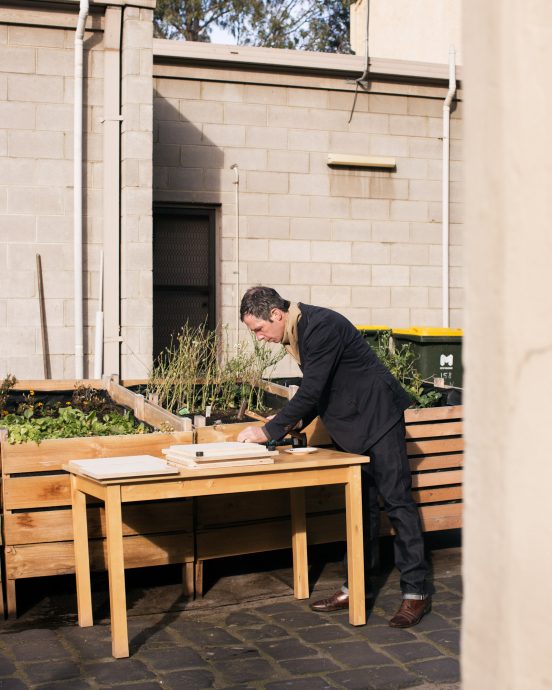
What is a swarm?
Swarming is the natural means of reproduction for honey bee colonies. Think of a honey bee colony as being both: a) lots of individual bees (say 30,000-100,000 sterile female worker bees, a couple of hundred male drones and one fertile queen) and b) a superorganism. The superorganism is all of these individuals – living cooperatively as one social intelligence – and their honeycomb infrastructure.
If you think of a bee colony in this manner, it then makes sense to say that the queen, as an individual bee, reproduces by laying eggs. And the bee colony, as a superorganism, reproduces by swarming. So, swarming is the natural means of reproduction for honey bee colonies. How? A new honey bee colony is formed when the queen bee leaves the colony with a large group of worker bees – the swarm. In the prime swarm, about 60 percent of the worker bees accompany the queen to the new location. This swarm can contain thousands to tens of thousands of bees. When it lands, it clusters into a ball and can range in size from a grapefruit to a basketball (or even bigger).
This cluster is at a temporary location, often only tens of metres from the original hive location – on a tree branch, under an eave, on a fence. The bees use this temporary base to take stock of their surrounds and scout out potential sites for the new, and permanent, home of the colony. This ball of bees is quite visible and is often caught by beekeepers – or destroyed by pest controllers.
How do the bees select a new home?
Scout bees head out from this temporary location to discover, and inspect, suitable permanent digs. If they find something of interest, they fly back to the colony and perform a ‘waggle dance’ on the surface of the swarm. This dance is a visual language seen by many of the worker bees and indicates the direction, and distance, of the potential new home (bees do a similar dance when communicating the location of food sources). Other scout bees that watch this dance then head off to have a look and, if they like the look of it, they return to the swarm and perform a similar dance. If they don’t like it, they don’t repeat the dance, and instead focus on locating or inspecting other sites. Many potential new homes are shortlisted, many dances are danced. The most suitable and popular sites (and dances) are repeated again and again and spread through the swarm like a viral marketing campaign. The shortlist gets smaller and smaller until one site – and its associated dance – is frenetically repeated all over the swarm surface. This is the critical mass; the tipping point. The energy levels pop and the swarm collectively decides it is time to fly off to its new home. This decision-making process usually takes a few days. This is dancing democracy, swarm intelligence,. the ‘hive mind’.
The scout bees, it turns out, are actually very picky about suitable home sites. Bees display quite specific preferences for the characteristics of their new homes and, thanks to the good work by researchers such as Professor Thomas D. Seeley, we now know what those preferences are. By designing suitable homes for the bees, we can attract the scout bees. We can, perhaps, offer them an alternative to setting up shop in unsuitable sites – such as schools, or compost bins, or inaccessible double brick cavity walls – where the pest controller is often called upon to destroy the colony.
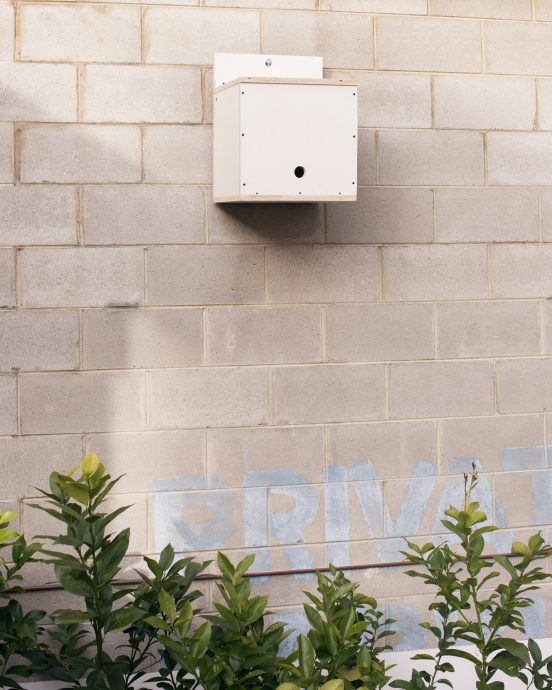
Professor Seeley’s ideal swarm trap
Swarm traps, or bait hives, attract bee swarms and can be used whenever swarms are expected – spring and early summer. The optimal volume of a swarm trap for Apis mellifera (the European honey bee) is between 14L and 40L (the size of a standard hive body). Larger swarms may prefer larger traps, smaller swarms prefer smaller traps.
An opening of approximately 3-5cm on the bottom of the hive is required as an entry. This hole can be crossed with two nails (or similar) to prevent entry by birds or small animals. The trap also needs similar-sized holes placed at the top of the structure to allow good ventilation. These should be covered in a mesh to stop other bees and insect pests entering (one entrance is easier to guard), and means there’s only the one (bottom) entrance to block during transport or relocation.
Although bees may nest in a variety of situations they seem to orient themselves towards high locations. Therefore, choose high points on the terrain with ample shade (for example, groves of high trees, or a shaded spot on a roof, or under an eave) for your swarm trap site. Place your swarm trap on a post, stand, tree or building at least 2.5m high. Bait hives should always face away from prevailing winds but receive morning sunlight if possible. In the southern hemisphere, orienting the entrance to the east or north is preferable.
Professor Seeley’s research indicated that bees weren’t too fussy about the shape of the trap – a cube, a cylinder, a blob are all good. The volume, orientation, location and entry hole to the trap appeared to be stronger determinants as to the hive’s suitability. This makes sense – in North Africa and parts of the Middle East traditional hives are horizontal cylinders. In Europe, hives were once logs – vertical and horizontal – then skeps (domes), then boxes. Bees will set up in various volumes.
A swarm trap needs a removable section (like a lid) to allow inspections and swarm removal. Some traps are large enough to accommodate a ‘drawn down’ (completed) honeycomb frame which acts as an attractant. If you’re a bee, it smells great, and you can smell it from quite a distance. Comb appeals to the bees’ innate preference for efficiency – it takes a great deal of honey (energy) and time to build comb from scratch – so why not find somewhere that already has some that’s ready to go? Frames also make swarm relocation easy – you can simply transfer a frame from the trap to a hive.
But this isn’t compulsory – or the only lure. A swarm can also be shaken, or brushed, from a trap and into to a beehive. And commercially available pheromone gels, that mimic queen bee pheromones, are sometimes irresistible to scout bees. The use of lemongrass essential oil (just a little smear inside the hive, or near the entrance) is very popular with natural beekeepers at the moment. Even the use of propolis as bait (propolis is a bee product made from plant materials, often referred to as ‘bee glue’) gets scout bees curious and warrants an investigation.
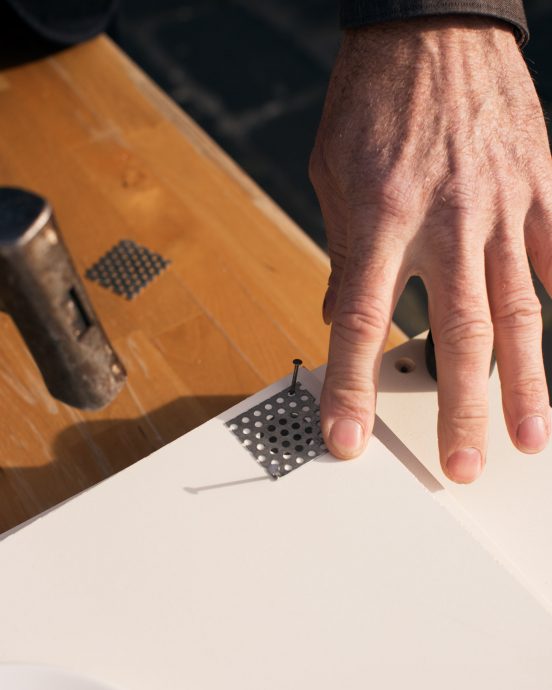
In summary, this is what bees want in real estate:
– a north-facing entrance, with some direct early morning light if possible
– located high off the ground (2.5m and up)
– highly visible
– shaded from hot, afternoon sun (a tree, an eave – not in full sun all day)
– 40L is ideal the ideal volume (avoid volumes less than 14L or greater than 100L)
– entrance hole of approx 3-5cm diameter
– entrance located 5cm from trap floor (not at the top)
– with drawn-down comb
– lemongrass oil, pheromone or similar lures
– Professor Seeley’s ‘ideal’ swarm trap, a version of which is photographed here, is a timber box, 350(L) x 350(W) x 370(H)mm, with a 30mm round hole at bottom of the front face
Become a beekeeper! Catch a swarm! But first, educate yourself and buy the appropriate equipment. Find a mentor, join a club, do a course, buy or borrow the right kit, read beekeeping books.
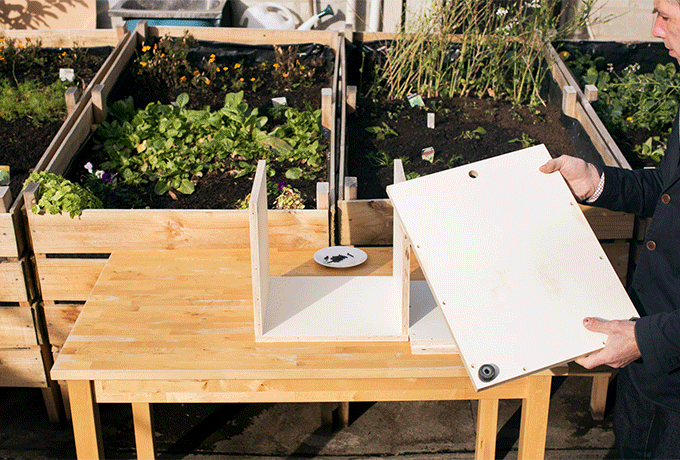
This swarm trap was designed by Mike Conole (pictured) in collaboration with Honey Fingers, to meet Prof. Seeley’s ideal dimensions. We used:
Cutting and materials list
1. Five pieces of 18mm ply offcuts, each with the following dimensions:
Two sides: 334 x 334mm
Front: 370 x 334mm
Back: 490 x 370mm
Base: 370 x 370mm
2. Weather stop (strip attached to back that removable lid slips under): 370 x 25mm
3. Entry hole 35mm diameter (spade bit to suit)
4. Ventilation holes 20mm diameter (spade bit to suit)
5. Hanging point on back (for bolt or similar in wall) 20mm diameter (spade bit to suit)
6. 2 x mesh (fly wire will do) to cover vents
7. 19 x countersunk 35mm screws (you can pre-drill 3mm holes)
Note: These measurements are guides only. Remember that bees will make a home in variously sized volumes. Stay within the guidelines described in this article and adapt dimensions and techniques to your skill level, the availability of materials and your personal style.
If you can’t cut materials to size, you can take these dimensions to a plywood supplier, or cabinet maker, who will do it for a fee. We encourage you to ask for offcuts – they may be cheaper to buy than whole sheets, and this project is perfect for extra bits and pieces that end up on the workshop floor.
If you want your trap to last more than a couple of seasons, it is a good idea to seal or paint it to limit warping. Use water-based, low VOC paints or sealants if possible and never paint inside a trap.
Nic Dowse is the founder of Honey Fingers. In the warmer months, when bees are chasing nectar, Honey Fingers is an urban beekeeping enterprise. In the cooler months, when the bees are inside eating their hard-earned honey, Honey Fingers is a collaborative studio practice. In addition to her work with Assemble, Rachel Elliot-Jones is the co-founder of Melbourne/Zurich-based curatorial and publishing platform Many Many. This spring/summer, Honey Fingers and Many Many join forces to present Swarm Trap – a series of programs and events designed to raise awareness of Australian bees, beekeeping and bee culture. Keep your eyes on the Swarm Trap website for trap-building workshop announcements and other ST-related news. Many thanks to Tom Ross for taking all the photos, Mike Conole for his ninja fingers and NORA for hosting a swarm trap above their inner-city garden beds, just metres from their kitchen. Having a go at catching a wild swarm that might, someday, make the honey on the NORA menu is all about bee-friendly, community connections that making a swarm trap encourages – swarmtrap.com.au.